Ads suck, right? Thanks to iOS ad blockers for iPhone, you can get rid of them.
Consider this scenario. You are playing an addictive game on
Don’t you want to know how to block ads on iPhone and iPad games? Cause this wasn’t even the worst-case scenario of ads ruining everything. What can you do to get rid of them, though? Don’t worry! I’ve got you covered. All you have to do is download any of these best ad-blockers for iOS that I’m gonna show you. But before we get down to the list, let’s talk more about the biggest issue concerning the internet this decade.
Now that those zombies in the game you were playing have killed you, you must be furious!
Why do you need Ad and content blockers?
Ad-blockers are applications that run scripts which in turn, disable other scripts that help run ads on websites. They are usually available in the form of apps on mobile devices and as plugins on desktops and laptops.
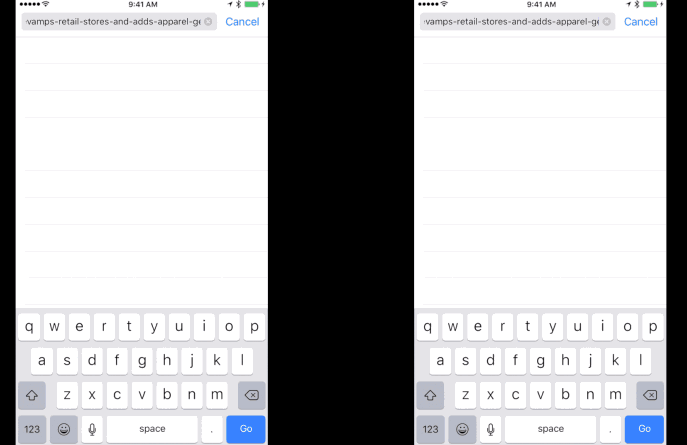
Left: without ad-blocker. Right: with ad-blocker
Credits: TheNextWeb
Removal of annoying scripts helps websites load faster, and makes it easier for users to navigate around. Additionally, in the process of making websites faster by removing ad scripts, it also saves battery and helps protect privacy.
Some ad-blockers offer additional features too. These include stuff like pop-up blockers, call to action blockers, etc. Disabling all of this may seem golden when you’re browsing. And especially on iPads, where browsing happens a lot; having an ad-blocker is a must, in my opinion. However, it has its disadvantages, too.
How Ad and content blockers don’t help?
No matter how peacefully ad-blockers may help you sift through your iPhone or iPad, blocking all of them is kind of unethical. You can and should, however, freely block ads that straight-up come in the way of you performing a task. Be it reading, playing a game, listening to music, watching a video; anything at all.

But blocking ads just for the fun of it cuts down the financial support that’s crucial for a website or an online entity to persist. And ad-blockers support that notion by not blocking all the ads on a website or an app; just the ones that really come in the way of normal functioning.
And this is why Apple became the prime focus of a lot of controversies when it launched support for adblocking apps. Capitalism, however, always wins. Isn’t it?
So, it’s advised in the best of everyone’s interest to never go on an adblocking spree.
Content Blockers VS Ad-blockers
When Apple launched support for adblocking, apps did not only take advantage of it by blocking ads, but also by blocking other elements of a webpage or an app. This significantly increases load times but breaks major stuff too.

Google Analytics- a tool used to track user interaction with the website, for instance, gets inhibited by content blocker apps like Crystal and Purify. This proves serious consequences for publishers trying to create a marketing strategy in order to achieve a better reach.
Never go on an ad-blocking spree
Most ad-blocker apps on iOS offer only adblocking. While some take it a notch higher and block other scripts as well. However, any app will do the job for you if your main goal is to only block ads. That said, how do you choose the best ad-blocker for iOS?
How to choose the best ad-blocker for iOS?
iOS is a huge and profoundly profitable platform for developers to work with. That being said, there are a ton of ad-blockers available on the App Store. But that also makes it difficult to choose one.
What you must look for in an ad-blocker?
- Adblocking capability, of course.
- Ability to manually whitelist and blacklist a website.
- Ability to do a lot more than just blocking ads.
- Must be free.
These are the guidelines that define a great ad-block app for iOS. A great adblock app, although, does not require to have all of these features. Most of these may work. Throw in cool app design and an easy-to-use interface and you’ve got yourself the best ad-blocker for iOS.
The best iOS ad-blocker, finally!
Now that we’ve vaguely pondered upon almost every question associated with adblocking, it’s time to see some apps that provide the best adblocking experience. Ready?
Purify- $1.99
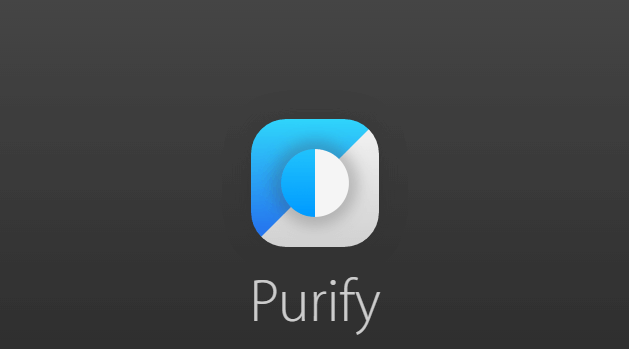
I know that I said the app should be free in order for it to be deemed the best. But, there’s so much that you get with Purify that you can’t get with any other apps in this list.
At its core, it’s an ad-blocker. Although, you can also block slightly unimportant stuff like custom fonts, social buttons, comments, scripts, and images. That pretty much leaves you with plain text. Further, it is mainly known for improving website load times by a significant margin. It also saves heck a lot of battery and data.
One thing that Purify boldly does is, it eliminates tracking. This is perfect for you. But a nightmare for website owners. Additionally, you must be thinking: offering this much must be pretty difficult to set up and manage. Thankfully, that’s not the case. Everything this app offers can be found in Safari’s share sheet. And most stuff happens just with a tap.
It’s a great catch if you are a privacy freak. Or, even if you are someone who prefers killing ads to load web pages faster and save battery, in turn. And this makes it the best ad-blocker for iOS
AdGuard Pro- $0.99
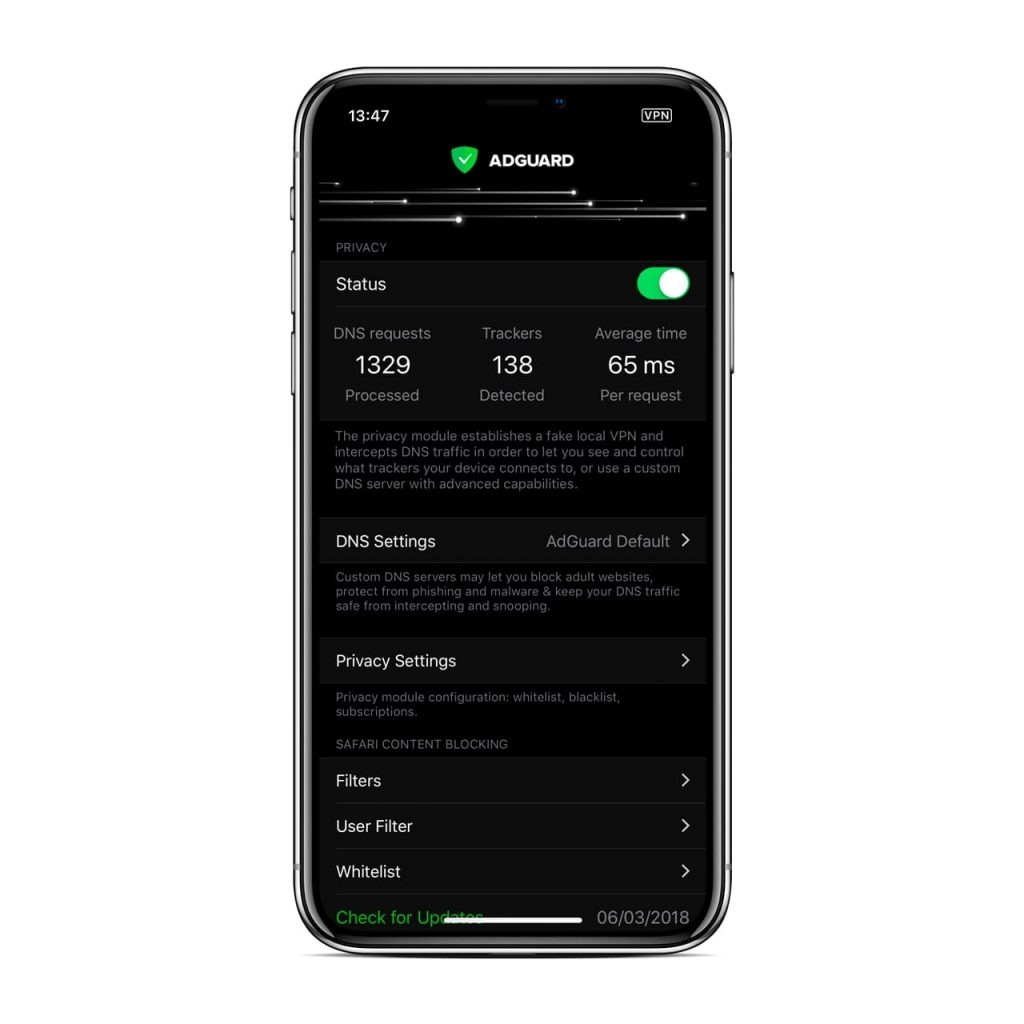
Unlike most other apps in this list, AdGuard Pro primarily focuses on leveraging DNS to block ads on your iPhone or iPad.
However, all it does is block ads and trackers. No content blocking. You can also whitelist and blacklist websites that you don’t want to see ads on. Another neat feature this app has is the ability to unblock websites that may have blocked you in the first place.
Aside from regular ad blocking, AdGuard pays deep emphasis on parental blocking. You can block websites that contain adult content automatically.
Wipr - $1.99
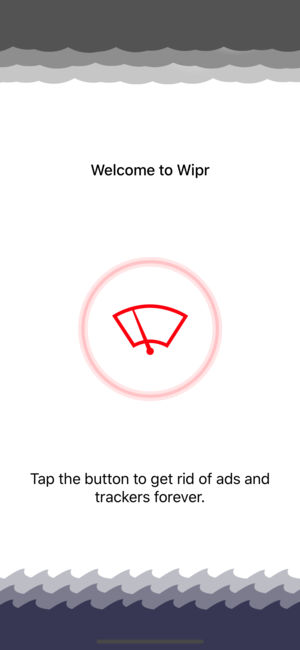
This is an app that is both honest and unconventional in its own way. Firstly, it offers a wide array of blocking services including ads, cryptocurrency miners, EU privacy notices, and other annoyances.
Like most other such apps, it also blocks tracking activity, which substantially increases page load times and saves data as well as battery. More on the subject. According to Wipr, it updates its filters twice a week, since the internet keeps updating every second or so. This means that you won’t have to manually blacklist websites every time. Sometimes, though, you’ll have to.
Further, there is absolutely nothing to configure when you first download this app. Everything is pre-packaged. You can, however, tweak some settings and manage a blacklist/whitelist. What you cannot do is block ads that appear outside the web; like in apps. It also doesn’t have extra content blocking features.
Wipr also openly states on its websites that it doesn’t accept any monetary support from ad companies to exclude their ads from its filter. Measures as such are ethically necessary. And I respect Wipr for that.
AdBlock for iOS- $1.99
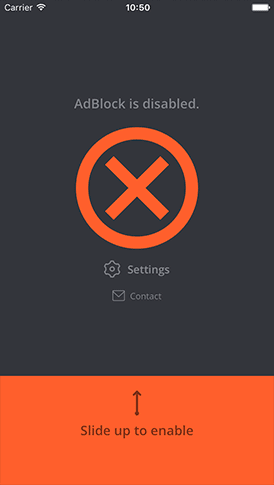
This is yet another app that lets you eradicate ads not only from websites but also from apps. Its main focus, though, is on apps.
You can also achieve privacy, thanks to AdBlock’s anti-tracking feature. For those who don’t know, this app has been around since iOS’ blooming days. Before Apple officially began supporting ad-blockers in iOS 9, AdBlock was available as a tweak for jailbreak users.
Ever
However, if you just want to get rid of nutty advertisements for now, AdBlock is your go-to app.
Firefox Focus- Free
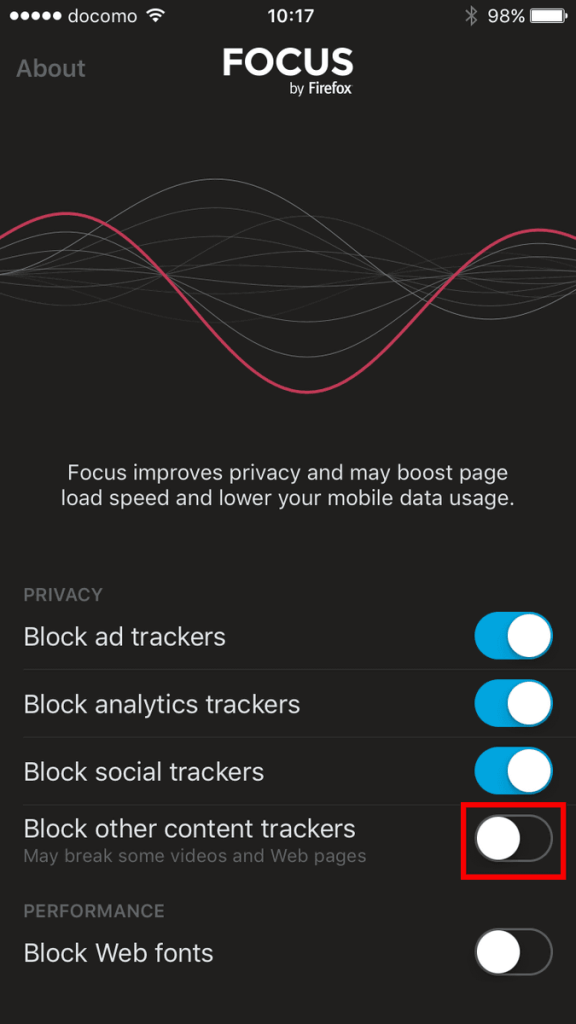
Firefox Focus is NOT an Ad-Blocker. But it’s definitely one all by itself. Confused?
It’s basically a browser that has ad and content blocking capabilities at its core. Although, that means you cannot block ads system-wide. Only ads that show in the Focus app itself while browsing websites will be blocked.
The reason for me to include this app in this list, however, is to emphasize that it kinda adds extra functionalities to most people’s already-favorite Firefox browser for iOS. It is de facto Firefox, but with extra functionalities.
As seen in the screenshot above, you can block ads, analytics trackers, social trackers, web fonts, and common elements from websites. That, in my opinion, is a shitload of stuff to block. And you won’t see many apps doing that. But, at the end of the day; it’s Mozilla.
BlockBear- Free
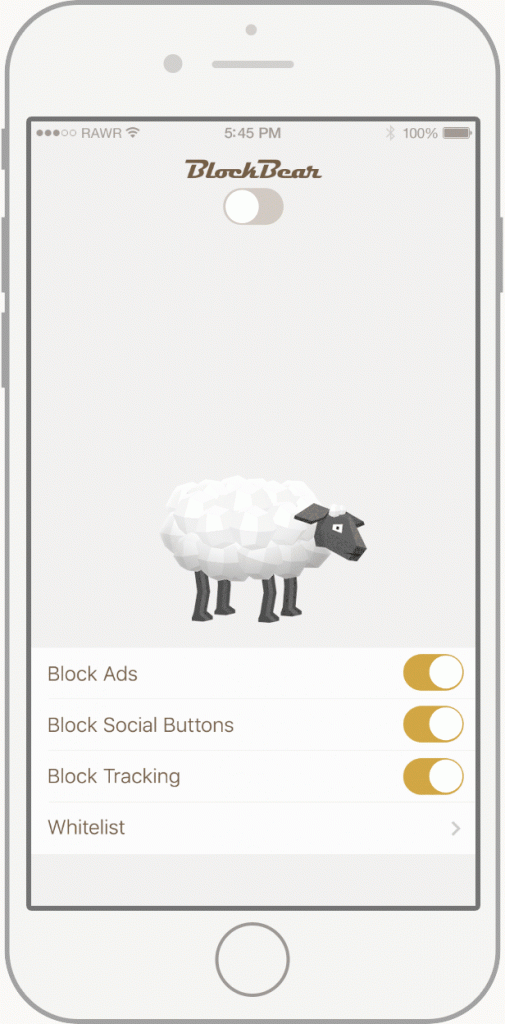
BlockBear comes from TunnelBear, who also sell one of the most talked-about VPN services.
That said, there is no way this app lacks in quality. Although, it does lack in features. For a mainstream publication app that isn’t a browser like Firefox’s Focus, its focus on blocking ads and scripts on just websites is a bit unsatisfactory.
At least on the web, it fights invasive tracking, blocks ads, and as a result; decreases page load times.
BlockBear also boasts that the app has “bears.” But I doubt that’s true, hmm!
Crystal- $0.99
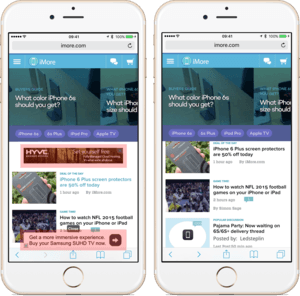
Crystal is a light-weight app that lives in the Safari share sheet.
The app has no configuration options. All you have to do is summon the share sheet and tap on the Crystal extension to disable all the ads and trackers from the website you are currently browsing.
Crystal dismembers the complexity that comes along with most content blockers and vents for a more simple, yet powerful experience. Though, the only grievance that I have with it is the fact that it isn’t available for free. You can get tons of other apps that do more than this and are also free. But, you won’t find anything that matches Crystal’s simplicity.
1Blocker- $4.99
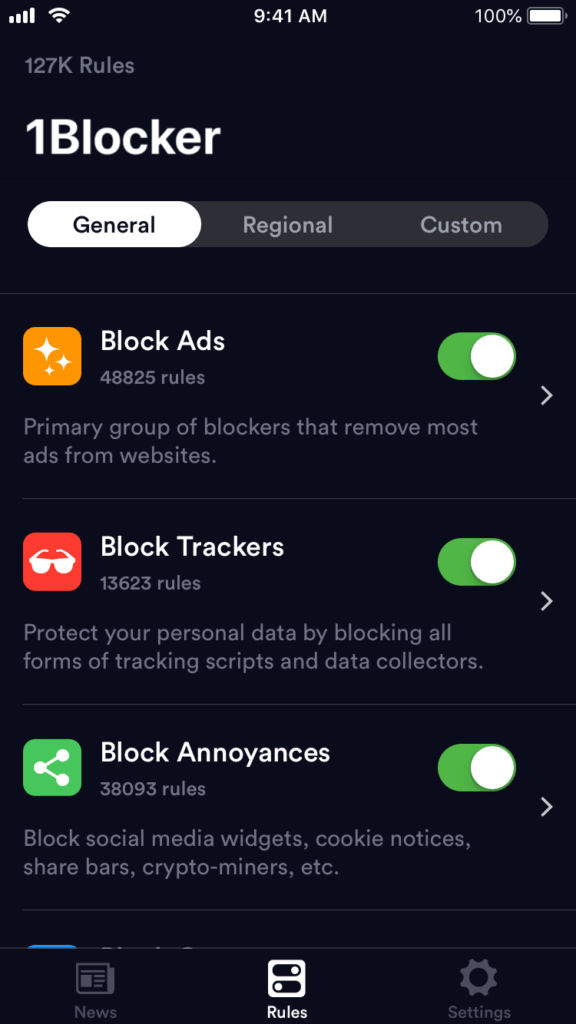
1Blocker is a unique app in itself. And the way I define its uniqueness is by the fact that it pushes the boundaries on stock iOS. What it does, seems like it can only be achieved with a jailbreak.
First and foremost; it does everything all the apps in this list do. So I’m not going to ponder over the details. Instead, I’ll run down what it does uniquely.
It has, unlike any other app in this list, a neat content blocking capability that blocks subscriber pop-up forms and relevant post nags. This is, however, not the highlight of this app. It also allows you to tap on different elements you don’t want on a web page and block them selectively. And that is beyond what looks like Apple might allow. But, this app does it. And it’s great.
What it does not block on the other hand, is internal ads that appear throughout iOS. For example, the Candy Crush ad in a zombie game.
Ka-Block!- Free
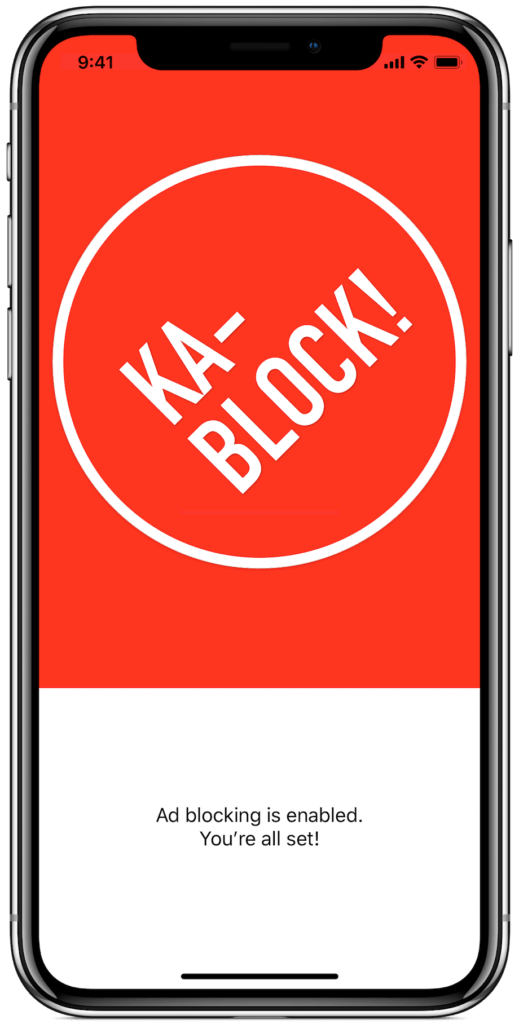
Despite having the coolest name an ad-blocker can have, “Ka-Block!” is quite limited in functionality.
The only things you can do with it is block ads and trackers, and that too, just on Safari. However, this doesn’t mean it’s not worth installing. If you’re tired only of ads displayed in Safari, this probably is the lightest, cleanest, and the most reliable app.
If at all you only want to get rid of ads that pester you in Safari, I would totally recommend this app over Crystal, which is another light-weight ad-blocker for Safari. And it’s also included in this list.
Punish Website- $2.99
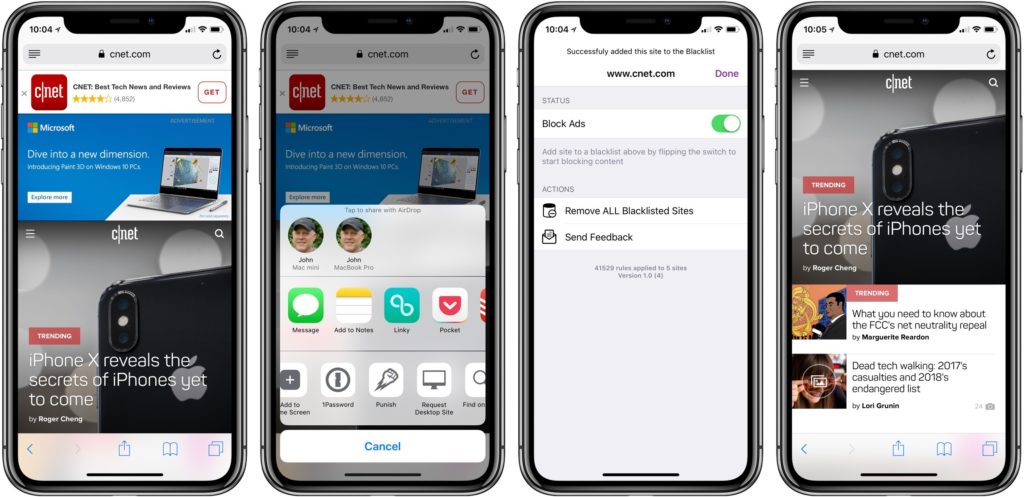
This app literally allows you to punish websites that show obstructive advertisements and track your behavior. Punish Website, ironically, is also the only app in this list that seems to righteously favor both publishers and end-users.
All you have to do is add the site that’s bothering you with ads to the app’s blacklist; either manually or by using its Safari share sheet extension. The share sheet extension, however, is a better way to blacklist than manually typing in the website’s URL.
Instead of performing the conventional function of blocking ads on all websites as soon as the app is installed, Punish Website saves publishers by giving them a chance to display them and users a chance to make a decision. At the end of the day, though, it is YOU that has the de facto control wand.
Unobstruct - $0.99
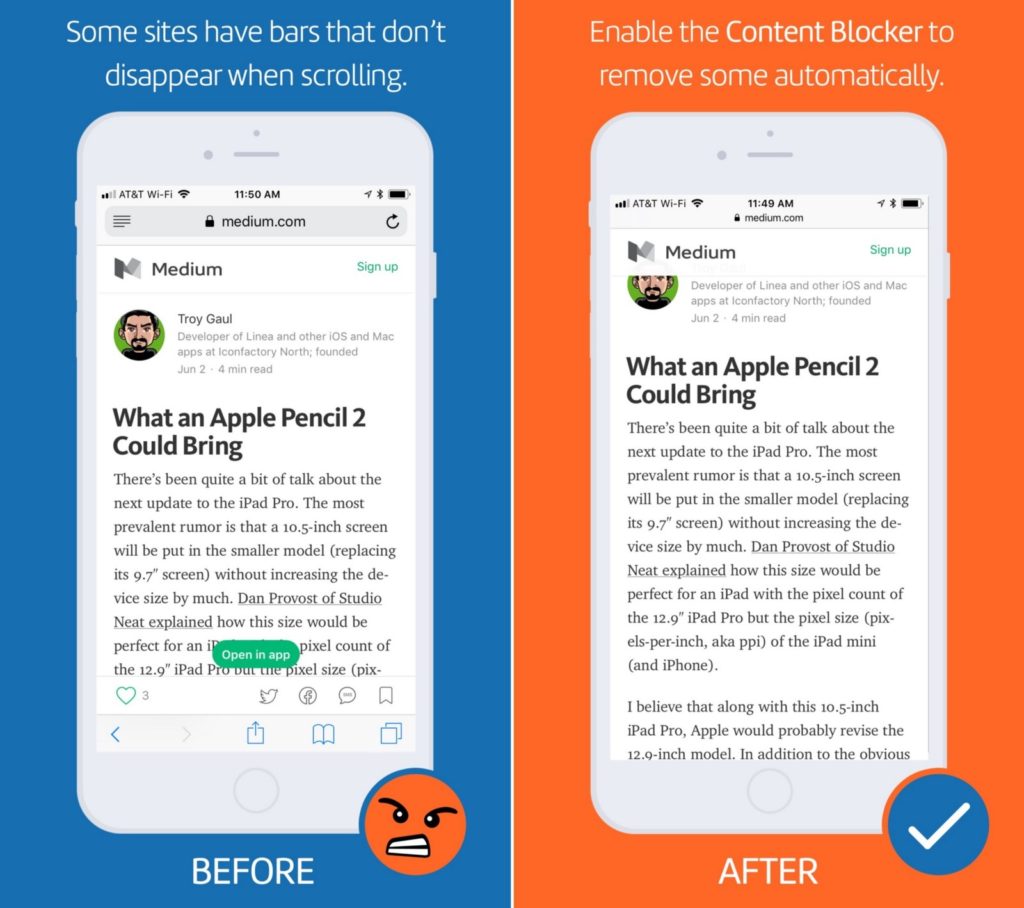
“Unobstruct” lives up to its name by eliminating elements in a web page that come in the way of normal tasks. It is by no means an ad-blocker, though. It’s a content blocker.
This app is well-known for eliminating elements like floating social buttons and announcements. However, if you are looking forward to remove the sticky header as well, “Unobstruct” won’t do that out of the box. This is because headers contain crucial information for a website including navigation.
You can, although, remove headers if you want by tapping on them after enabling this app from the share sheet in Safari.
Cake Browser- Free
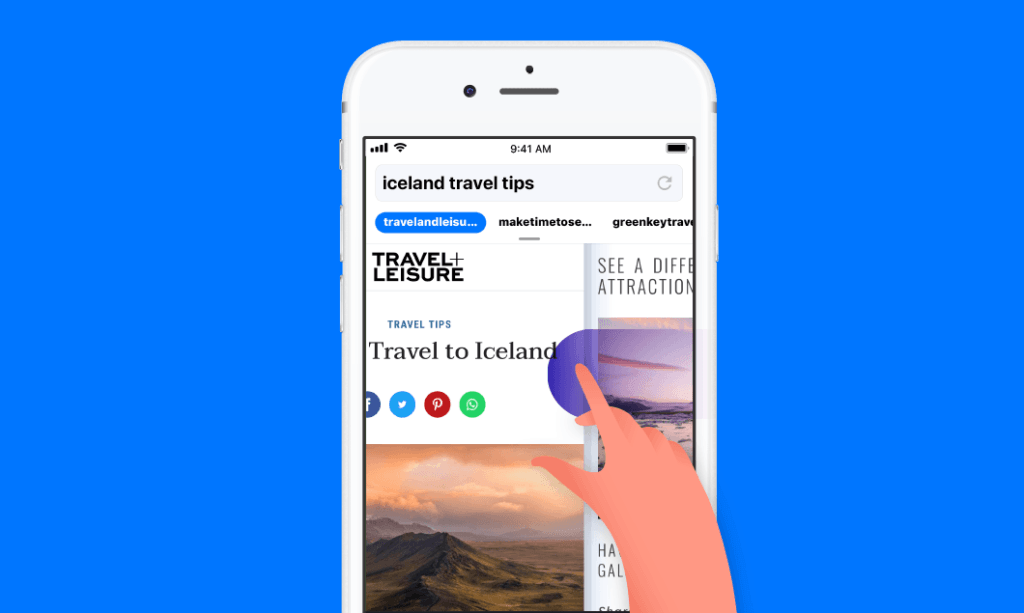
Cake Browser is a browser with additional ad-blocking and tracking-blocking technology. On the plus side, you also get a unique browsing experience.
I’ve reviewed this browser separately, and it has by far the best methods to counter the technical lethargy that emerges while you browse websites on your phone. And how does it do that? By automatically loading search engine result pages instead of arranging them in a list, like Google originally does.
It also automatically preloads the next results while you are on the first result, which makes websites load faster. And part of that website page load speed is owing to Cake’s ad-blocking algorithm.
Brave Browser- Free
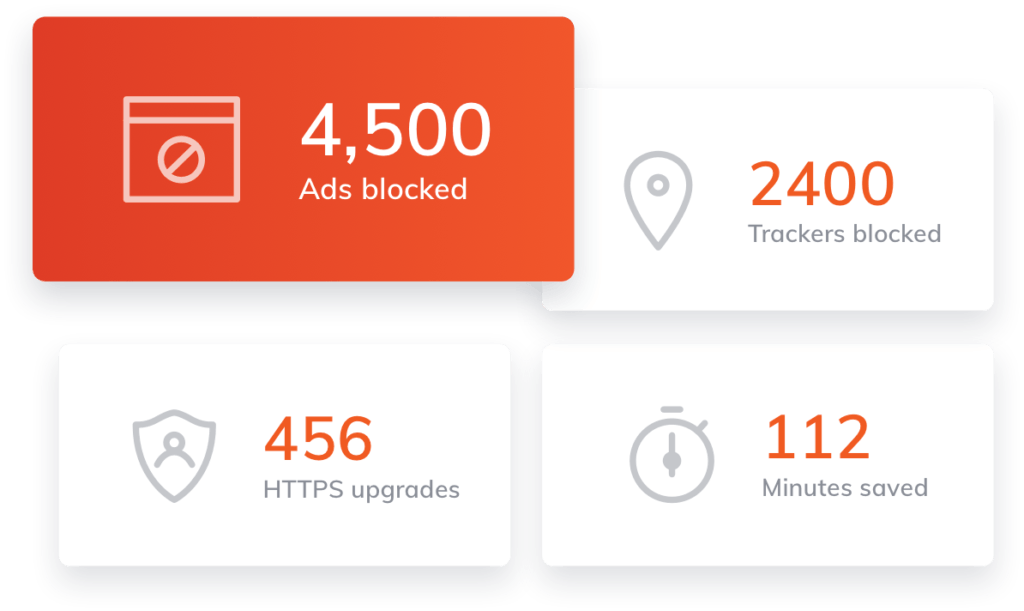
Brave is yet another browser in this list that falls out of the way to provide exceptional ad-blocking and tracking features. Except, Brave’s only job is to make websites load faster and to ensure user privacy by blocking advert scripts, tracking scripts, and other similar stuff.
It also does its part with regard to ethics by urging users to donate cryptocurrency to websites as a measure to support them financially; now that you’re blocking one of their sources of revenue. As a result, there are many minor websites that use Brave as a mainstream revenue source.
For you-the end user, though-it provides exceptional ad-blocking and tracking-blocking technologies. In turn, that increases page load speeds while also saving device battery and cellular data at the same time.
iCareFone- Free
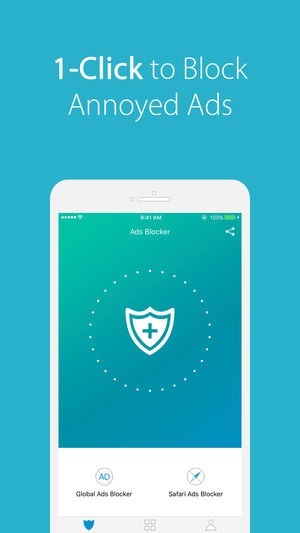
From the Apple device workaround software giant Tenorshare, this app provides the ultimate solution to inescapable content no matter what you’re currently doing on your iPhone.
Block all types of ads with more than 32,000 rules, disable cookies, block analytics tracking, block pictures, block fonts, block adult sites. You name it, iCareFone does it.
StopAd- Free
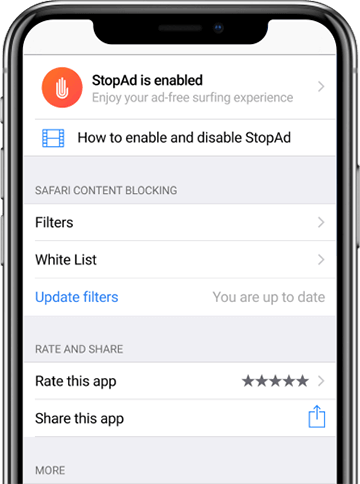
StopAd is a worthy alternative for almost every app featured in this list.
It offers all the ad-blocking and tracking-blocking features and couples it with additional security features like malware and phishing protection. However, these security features are uncalled for. Especially since iOS has tight ropes around its boundaries that mostly leave no room for malware and phishing attacks.
In simple words, iOS does not need the security offered by StopAd because it has its own, which is also the best-in-its-class.
Sanitize- Free
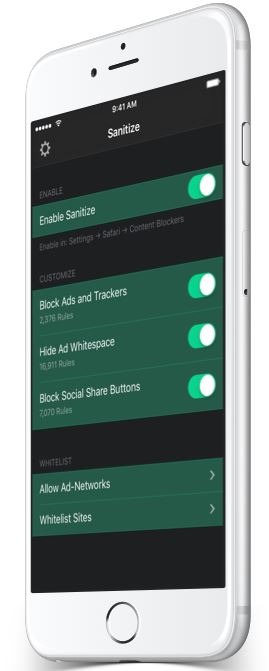
“The web is dirty. Let’s sanitize it.” This is what Sanitize’s web page says on the very first line.
But that’s not false, by any margin. The web is indeed dirty. Yet, Sanitize, in my opinion, offers very less to clean it. Rather, “sanitize” it.
It provides ad and tracker blockers. After it disables ads, it also removes the whitespace those ads leave behind in its quest to provide a unmistakable user experience. Additionally, you can also block social share buttons.
Refine- $0.99
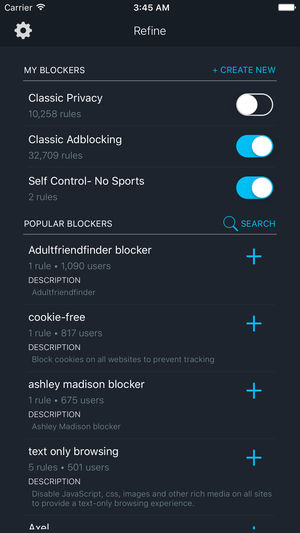
If you are looking for more control, this complicated ad-blocker provides it.
Refine is backed by a user-base that collectively create all kinds of filters. So the customization factor is quite impressive for this ad-blocker. And thanks to the extent of its customizability, this content blocker blocks almost anything!
Conclusion
Now that you’ve achieved a blissful, ad-free browsing capability, let’s retouch on a few things.
Ads have been a major part of internet commercialization ever since the internet itself popped into existence. Further, they are the only means of monetization for a buttload of websites today. Providing the end-user, although, with the power to shift the spectrum becomes necessary when advertisers exceed their limits.
It is not the very concept of ads that enrage a mind. It is, indeed, its obtrusive nature that urges people to intercede.
Apple, as always, rightfully caters need against want. And that, at its core, has been able to enlist the Cupertino-based company in the “Trillion-dollar club.” It’s soothing to learn Apple taking a bold move in order to provide users the experience that they signed up for. And ad-blocking support in iOS is a perfect reflection of that.
Nevertheless, these were the best ad-blockers for iOS that you can choose from. Do consider the points that I mentioned earlier in this post in order to make sure you do not choose the one that you don’t want.
Now, let’s get back to our game. You close the app after the Candy Crush ad killed your character. You read this post and influenced by it, download an ad-blocker. Satisfied, you tap on the zombie game icon again. You start the game. Zombies begin to arrive. You dodge. Zombies are nearing. They killed you. But this time, it wasn’t because of some shitty ad. So, it’s alright!
That said, tell me; which are your favorite ad-blockers for iPhone and iPad? What do you think about the ethical viewpoint while installing ad-blockers? Fire-up in the comments below! Thanks a lot!
The 8-Bit does not earn commissions from the apps featured in this post. Further, it does not favor any of them by any means. This post is purely based on an unbiased perspective.
